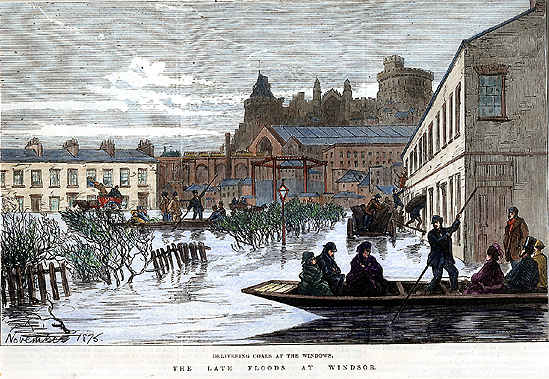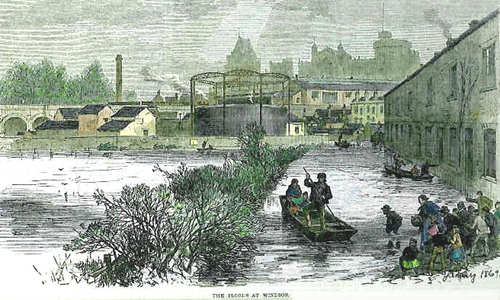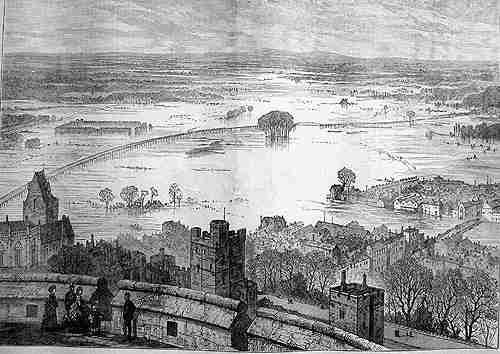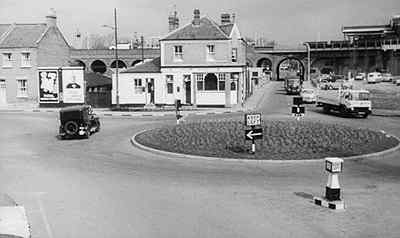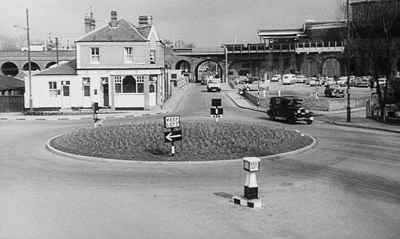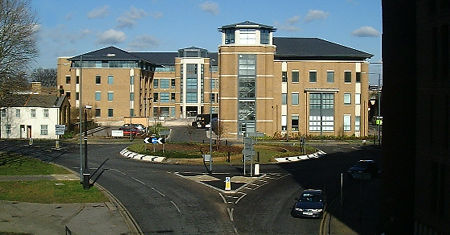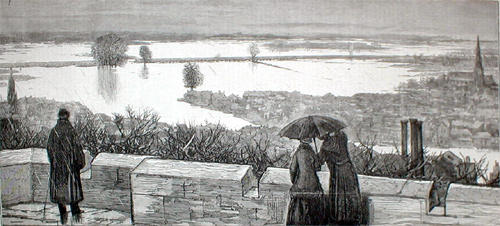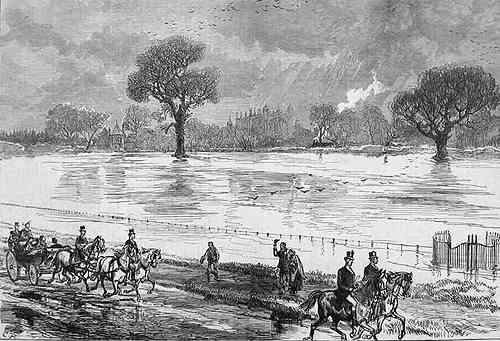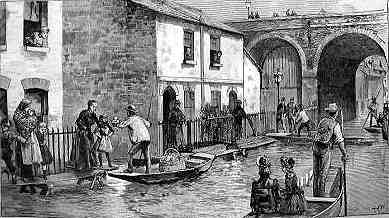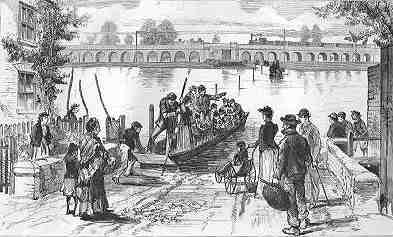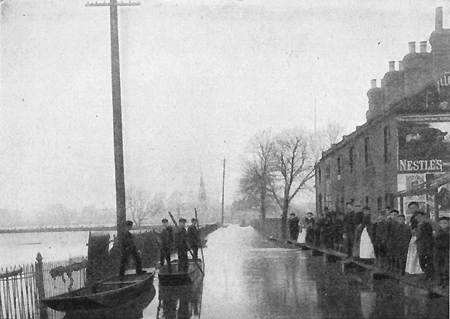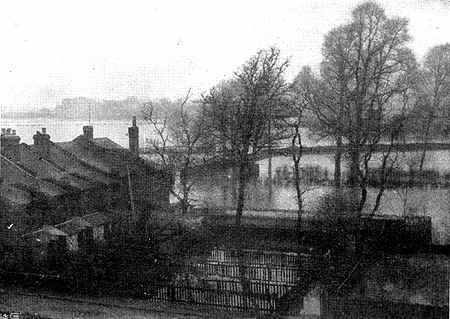
|
Index |
|
River Thames |
|
Royal
Windsor Home Page
Introduction
It is not widely known that in Victorian times, Windsor, and also the rest of the country, suffered flooding far more regularly than in the 20th century. Although this can partly be blamed on less effective river management, there must also be an element of extreme weather conditions. For example, a particularly severe flood seems to have occurred in 1852, the Illustrated London News reporting that the floods of December 1872 were some two feet lower than the floods of 1852. It has also been reported that a severe flood, possibly worse than 1894 occurred in 1774. Here we reproduce various reports and pictures published in the 19th century sometimes with unimaginative headline writing!
January 1869
From The Illustrated London News January 16th 1869
THE LATE FLOODS The extraordinary quantity of rain that has fallen in most parts of England during the last three weeks has caused the overflow of many rivers and the flooding of extensive tracts of land....
...The waters also rose considerably at Windsor and Eton where the scene was indeed remarkable as viewed from the north and east terraces of Windsor Castle. For several miles the natural course of the river and its windings were lost in a succession of inland lakes. Between Maidenhead and Staines thousands of acres of meadow and pasture land were inundated, the ditches, watercourses and rivulets being filled to overflowing. At Eton College portions of the playing fields were under water, the Brocas on the west side of the town, where the spectators assemble on June 4th to see the regatta was likewise partly submerged The south meadow, well known as the site upon which are celebrated the annual college athletic sports, formed the bottom of a fine sheet of water. In fact the town and college of Eton appeared to be situated upon a peninsula, so much water was lying west and east of the town. Upon the south shore of the river the swollen Thames had invaded the royal demesne, much of the Home Park facing the north and east terraces of the castle being under water. The land in the western environs of Windsor had a deal of water upon it, The Goswells, adjoining the Gardner estate, and near the Windsor gas works were partly inundated and the floods surrounded Taylor's baths. ... Except the rapid flow of the current, there was a remarkable aspect of stillness about the flooded valley.
The flood in Windsor in January 1869 pictured in The Illustrated London News.
A similar view was to be published during the floods of November 1875, see below.January 1872
From TheGraphic Magazine February 10th 1872. p.137
THE FLOODS AT WINDSOR AND ETON
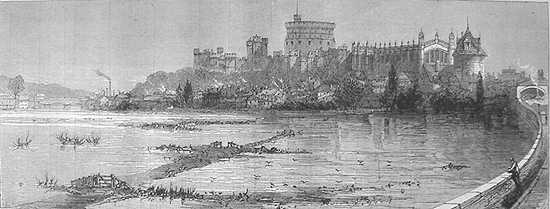
Thursday and Friday 25th and 26th January 1872.
A view from the GWR railway viaduct towards Windsor, with the floodwater reaching the lower areas of the town.In the course of Thursday the 25th and Friday the 26th ult. the water of the Thames rose considerably in the Windsor and Eton district, and as a consequence large tracts of land were inundated by the floods which have poured down the river from the west country
Between Maidenhead and Windsor much of the land on the banks of the Thames was under water, the choked rivulets and ditches adding to the inundation. At Clewer the stream rolled over portions of the Rays on which is situated the Windsor racecourse. Parts of the South Meadow west of Eton and also of the Playing Fields near Eton College were submerged, and much of Romney Island was under water, which rose on the Home Park opposite the Castle. The inundation spread round Taylor's Baths on the Windsor side of the river, and the swollen stream, rushing rapidly between the two towns, washed into Goodman's s boathouse, Salter's and Tolladay's, being threatened with a similar visitation.
In the Datchet, Wraysbury, and Staines districts there was also much land under water, the the. flood being more extensive than has been witnessed for the last two or three years.
On the 30th the floods began to subside and the comparitively dry weather since experienced has relieved the land of its watery burden. Similar floods have taken place in Nottinghamshire, Leicestershlre, and in the west of England.
December 1872 & January 1873
From The Illustrated London News January 4th 1873
THE LATE FLOODS The valley of the Thames, from Staines to above Windsor, and up to Maidenhead, presented an extraordinary spectacle during the floods, which covered miles of the low lands on each bank of the river in the week before Christmas. The lower parts of the town at Windsor and Eton were inundated to a depth of several feet in some places, so that the inhabitants of Cambridge Terrace and Oxford Road were obliged to use punts to and from their dwellings. When Divine worship was performed on the Sunday at the parish church of Bray, half a dozen boats were constantly employed to bring the congregation over the adjacent water; and the country people coming to market on other days reached Maidenhead by a similar conveyance. The view from the Round Tower of Windsor Castle, which is shown in the Illustration below, was exceedingly strange. The Eton College playing fields, the Brocas and the neighbouring meadows, the ground about the Provost's Fishing Lodge at Black Potts, and Romney Isle, below the bridge, with a vast extent of land at Chalvey, Eton Wick, and Dorney, were submerged. The town and college were almost surrounded with water, and converted into a peninsula. In the opposite direction the floods covered nearly all the Home Park to the north and east of the castle, and spread over the meadows of Datchet, Old Windsor, Magna Charta Island and Runnymede to Staines Moor. The flood here was not, indeed, so high by 2 ft. as that of 1852, which was the highest on record, and much relief was afforded by the newly-constructed weirs and tumbling bays near Windsor, as appears from a letter of Mr W. Menzies, Deputy Surveyor of the Royal Park. The works of the Windsor Castle Sewage Farm went on without interruption.
The Floods of early January 1873 from The Round Tower
November 1875
